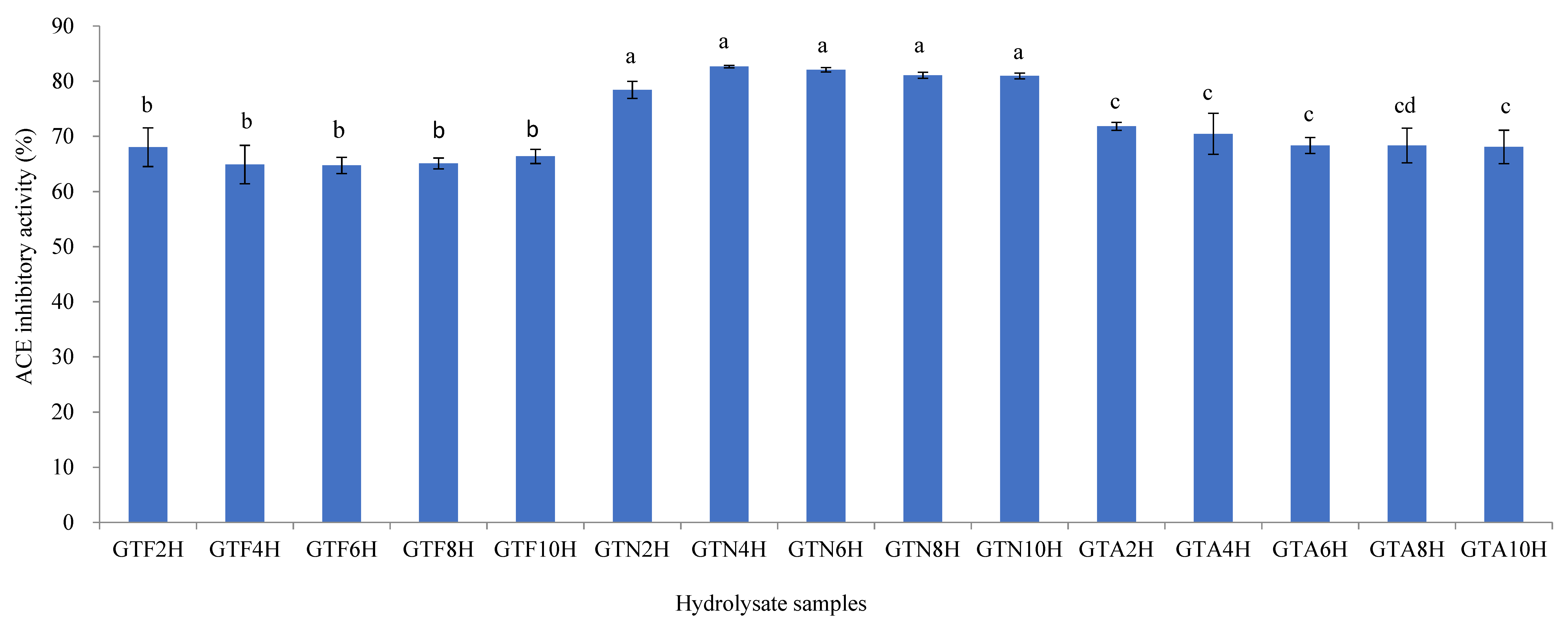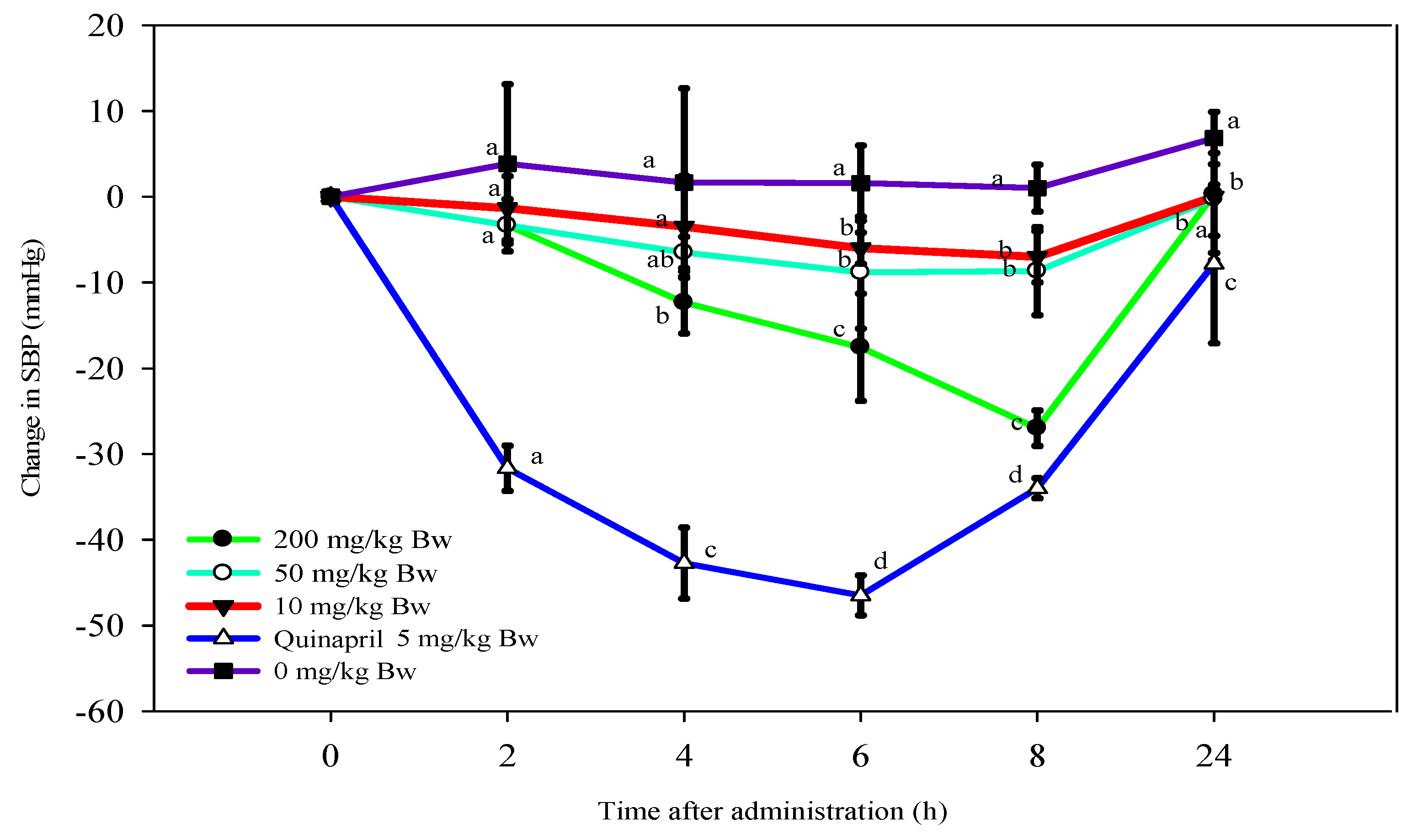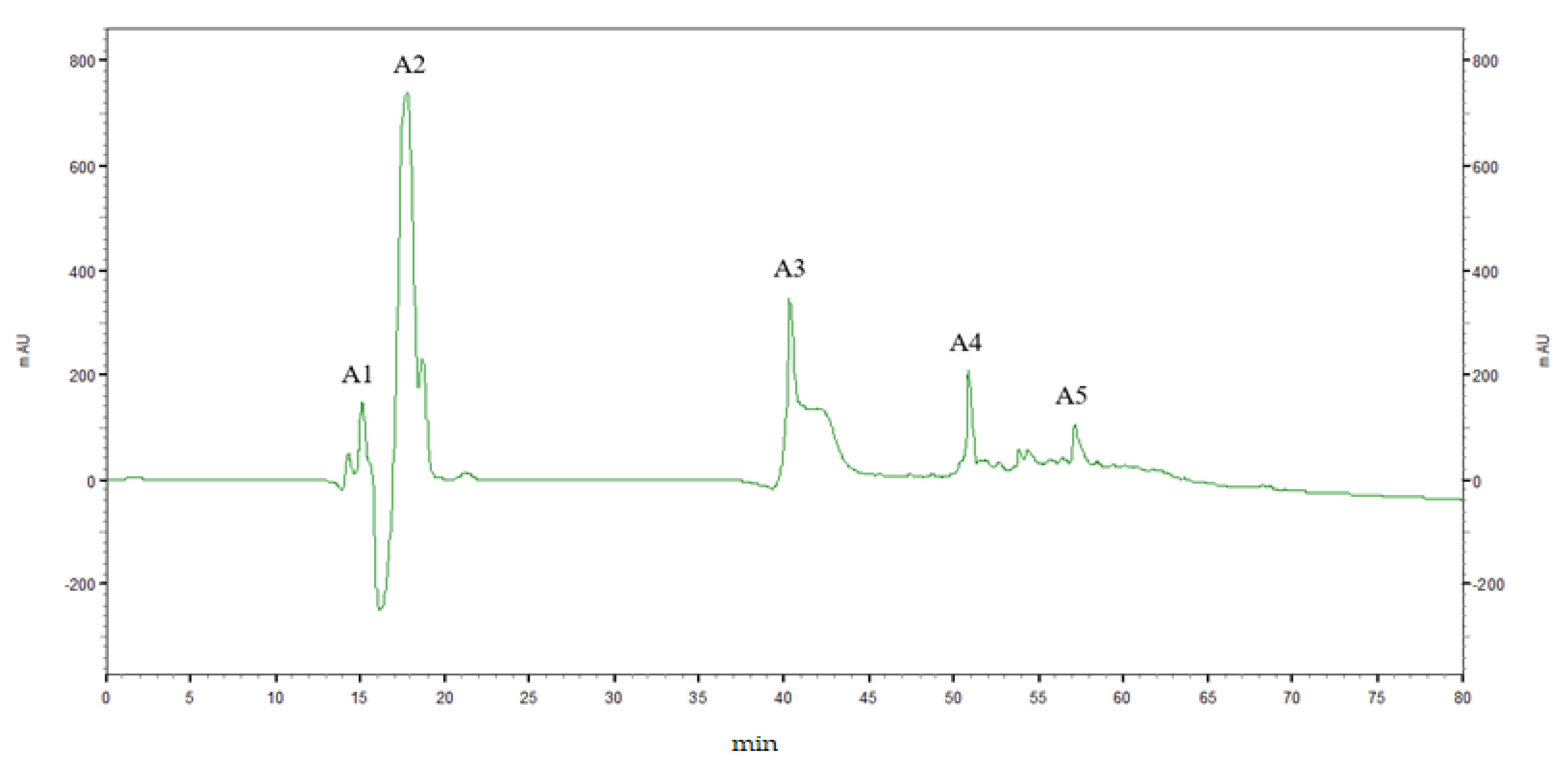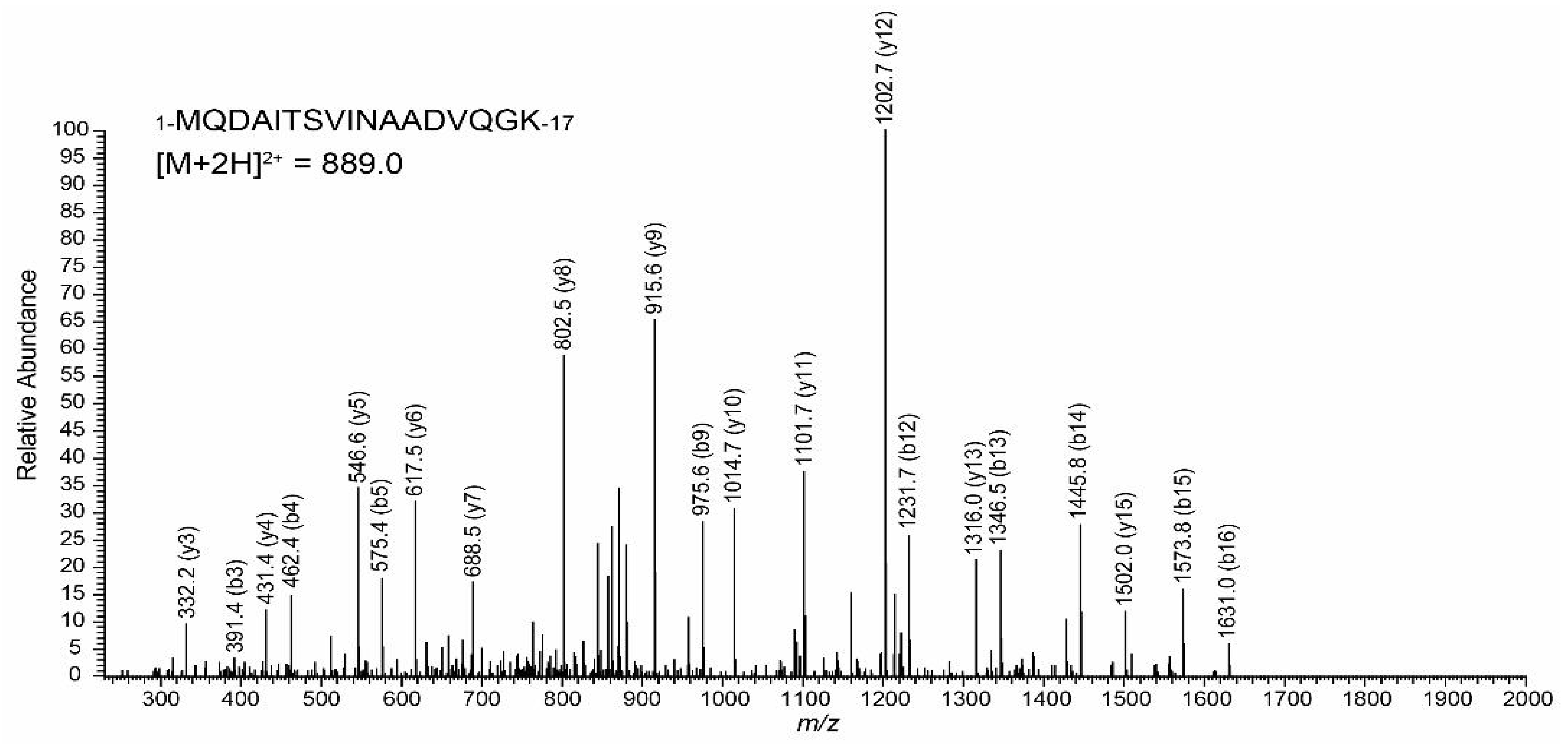Purification and Identification of an ACE-Inhibitory Peptide from Gracilaria tenuistipitata Protein Hydrolysates
Abstract
:1. Introduction
2. Materials and Methods
2.1. Algal Material
2.2. Chemicals
2.3. Preparation of the Gracilaria tenuistipitata Protein Hydrolysate
2.4. In vitro ACE-Inhibitory Activity
2.5. Purification of ACE-Inhibitory Peptides
2.5.1. Gel Filtration Chromatography
2.5.2. Reversed-Phase HPLC Analysis
2.6. Peptide Sequencing Analysis
2.7. Animal Experiment
2.7.1. Source and Breeding Conditions of Experimental Animals
2.7.2. Animal Grouping
2.8. Statistical Analysis
3. Results and Discussion
3.1. Yield Content of the Enzymatic Extracts
3.2. In Vitro Analysis of ACE-Inhibitory Activity of Gracilaria tenuistipitata Protein Hydrolysate
3.3. Animal Experiments
3.4. Gel Filtration Chromatography of GTN4H
3.5. Second Purification
3.6. Sequence Identification of A4
4. Conclusions
Author Contributions
Funding
Institutional Review Board Statement
Informed Consent Statement
Data Availability Statement
Acknowledgments
Conflicts of Interest
References
- He, J.; Whelton, P.K. Elevated systolic blood pressure and risk of cardiovascular and renal disease: Overview of evidence from observational epidemiologic studies and randomized controlled trials. Am. Heart J. 1999, 138, S211–S219. [Google Scholar] [CrossRef]
- Stamler, J.; Stamler, R.; Neaton, J.D. Blood pressure, systolic and diastolic, and cardiovascular risks. US population data. Arch. Intern. Med. 1993, 153, 598–615. [Google Scholar] [CrossRef] [PubMed]
- Kearney, P.M.; Whelton, M.; Reynolds, K.; Muntner, P.; Whelton, P.K.; He, J. Global burden of hypertension: Analysis of worldwide data. Lancet 2005, 365, 217–223. [Google Scholar] [CrossRef]
- Li, G.-H.; Le, G.-W.; Shi, Y.-H.; Shrestha, S. Angiotensin I–converting enzyme inhibitory peptides derived from food proteins and their physiological and pharmacological effects. Nutr. Res. 2004, 24, 469–486. [Google Scholar] [CrossRef]
- Collins, K.G.; Fitzgerald, G.F.; Stanton, C.; Ross, R.P. Looking beyond the terrestrial: The potential of seaweed derived bioactives to treat non-communicable diseases. Mar. Drugs 2016, 14, 60. [Google Scholar] [CrossRef] [Green Version]
- Kim, S.-K.; Wijesekara, I. Development and biological activities of marine-derived bioactive peptides: A review. J. Funct. Foods 2010, 2, 1–9. [Google Scholar] [CrossRef]
- Liu, J.; Yu, Z.; Zhao, W.; Lin, S.; Wang, E.; Zhang, Y.; Hao, H.; Wang, Z.; Chen, F. Isolation and identification of angiotensin-converting enzyme inhibitory peptides from egg white protein hydrolysates. Food Chem. 2010, 122, 1159–1163. [Google Scholar] [CrossRef]
- Cheung, R.C.; Ng, T.B.; Wong, J.H. Marine peptides: Bioactivities and applications. Marine Drugs 2015, 13, 4006. [Google Scholar] [CrossRef]
- Admassu, H.; Gasmalla, M.A.; Yang, R.; Zhao, W. Bioactive peptides derived from seaweed protein and their health benefits: Antihypertensive, antioxidant, and antidiabetic properties. J. Food Sci. 2018, 83, 6–16. [Google Scholar] [CrossRef] [Green Version]
- Armisen, R. World-wide use and importance of Gracilaria. J. Appl. Phycol. 1995, 7, 231. [Google Scholar] [CrossRef]
- Harnedy, P.A.; FitzGerald, R.J. Bioactive proteins, peptides and amino acids from macroalgae. J. Phycol. 2011, 42, 218–232. [Google Scholar] [CrossRef] [PubMed]
- Chiang, Y.-M.; Lin, J.-L. Nitrate uptake by nitrogen-starved plants of the red alga Gracilaria tenuistipitata var. liui. Jpn. J. Phycol. 1989, 37, 187–193. [Google Scholar]
- Ajisaka, T.; Chiang, Y.-M. Recent status of Gracilaria cultivation in Taiwan. Hydrobiologia 1993, 260, 335–338. [Google Scholar] [CrossRef]
- Daud, N.A.; Ghassem, M.; Fern, S.S.; Babji, A.S. Functional bioactive compounds from freshwater fish, edible birdnest, marine seaweed and phytochemical. Am. J. Food Nutr. 2016, 6, 33–38. [Google Scholar] [CrossRef]
- Fleurence, J. Seaweed proteins: Biochemical, nutritional aspects and potential uses. Trends Food Sci. Technol. 1999, 10, 25–28. [Google Scholar] [CrossRef]
- Cermeño, M.; Kleekayai, T.; Amigo-Benavent, M.; Harnedy-Rothwell, P.; FitzGerald, R.J. Current knowledge on the extraction, purification, identification, and validation of bioactive peptides from seaweed. Electrophoresis 2020, 41, 1694–1717. [Google Scholar] [CrossRef]
- Herrero, M.; Cifuentes, A.; Ibañez, E. Sub- and supercritical fluid extraction of functional ingredients from different natural sources: Plants, food-by-products, algae and microalgae: A review. Food Chem. 2006, 98, 136–148. [Google Scholar] [CrossRef] [Green Version]
- Bleakley, S.; Hayes, M. Algal proteins: Extraction, application, and challenges concerning production. Foods 2017, 6, 33. [Google Scholar] [CrossRef] [Green Version]
- Wijesinghe, W.A.; Jeon, Y.-J. Enzyme-assistant extraction (EAE) of bioactive components: A useful approach for recovery of industrially important metabolites from seaweeds: A review. Fitoterapia 2012, 83, 6–12. [Google Scholar] [CrossRef]
- Siriwardhana, N.; Kim, K.-N.; Lee, K.-W.; Kim, S.-H.; Ha, J.-W.; Song, C.B.; Lee, J.-B.; Leon, Y.-J. Optimisation of hydrophilic antioxidant extraction from Hizikia fusiformis by integrating treatments of enzymes, heat and pH control. Int. J. Food Sci. Technol. 2008, 43, 587–596. [Google Scholar] [CrossRef]
- del Pilar Sánchez-Camargo, A.; Montero, L.; Stiger-Pouvreau, V.; Tanniou, A.; Cifuentes, A.; Herrero, M.; Ibañez, E. Considerations on the use of enzyme-assisted extraction in combination with pressurized liquids to recover bioactive compounds from algae. Food Chem. 2016, 192, 67–74. [Google Scholar] [CrossRef] [PubMed]
- Le Guillard, C.; Bergé, J.-P.; Donnay-Moreno, C.; Bruzac, S.; Ragon, J.-Y.; Baron, R.; Fleurence, J.; Dumay, J. Soft liquefaction of the red seaweed Grateloupia turuturu Yamada by ultrasound-assisted enzymatic hydrolysis process. J. Appl. Phycol. 2016, 28, 2575–2585. [Google Scholar] [CrossRef] [Green Version]
- Kumagai, Y.; Kitade, Y.; Kobayashi, M.; Watanabe, K.; Kurita, H.; Takeda, H.; Yasui, H.; Kishimura, H. Identification of ACE inhibitory peptides from red alga Mazzaella japonica. Eur. Food Res. Technol. 2020, 246, 2225–2231. [Google Scholar] [CrossRef]
- Sumikawa, K.; Takei, K.; Kumagai, Y.; Shimizu, T.; Yasui, H.; Kishimura, H. In silico analysis of ACE inhibitory peptides from chloroplast proteins of red alga Grateloupia Asiat. Mar. Biotechnol. 2020, 22, 391–402. [Google Scholar] [CrossRef] [PubMed]
- Park, P.-J.; Heo, S.-J.; Park, E.-J.; Kim, S.-K.; Byun, H.-G.; Jeon, B.-T.; Jeon, Y.-J. Reactive oxygen scavenging effect of enzymatic extracts from Sargassum thunbergii. J. Agric. Food Chem. 2005, 53, 6666–6672. [Google Scholar] [CrossRef]
- Sato, M.; Hosokawa, T.; Yamaguchi, T.; Nakano, T.; Muramoto, K.; Kahara, T.; Funayama, K.; Kobayashi, A.; Nakano, T. Angiotensin I-converting enzyme inhibitory peptides derived from wakame (Undaria pinnatifida) and their antihypertensive effect in spontaneously hypertensive rats. J. Agric. Food Chem. 2002, 50, 6245–6252. [Google Scholar] [CrossRef]
- Wu, J.; Ding, X. Characterization of inhibition and stability of soy-protein-derived angiotensin I-converting enzyme inhibitory peptides. Food Res. Int. 2002, 35, 367–375. [Google Scholar] [CrossRef]
- Habeebullah, S.F.; Alagarsamy, S.; Sattari, Z.; Al-Haddad, S.; Fakhraldeen, S.; Al-Ghunaim, A.; Al-Yamani, F. Enzyme-assisted extraction of bioactive compounds from brown seaweeds and characterization. J. Appl. Phycol. 2020, 32, 615–629. [Google Scholar] [CrossRef]
- Echave, J.; Fraga-Corral, M.; Garcia-Perez, P.; Popović-Djordjević, J.; HAvdović, E.; Radulović, M.; Xiao, J.; APrieto, M.; Simal-Gandara, J. Seaweed Protein Hydrolysates and Bioactive Peptides: Extraction, Purification, and Applications. Mar. Drugs 2021, 19, 500. [Google Scholar] [CrossRef]
- Taiwan Food and Drug Administration. Evaluation method of auxiliary blood pressure regulation of healthy food. 2018. Available online: https://consumer.fda.gov.tw/Law/Detail.aspx?nodeID=518&lawid=178&k=%u5065%u5EB7%u98DF%u54C1%u4E4B%u8F. (accessed on 4 May 2006).
- Ko, S.-C.; Kang, N.; Kim, E.-A.; Kang, M.C.; Lee, S.-H.; Kang, S.-M.; Lee, J.-B.; Jeon, B.-T.; Kim, S.-K.; Park, S.-J.; et al. A novel angiotensin I-converting enzyme (ACE) inhibitory peptide from a marine Chlorella ellipsoidea and its antihypertensive effect in spontaneously hypertensive rats. Process Biochem. 2012, 47, 2005–2011. [Google Scholar] [CrossRef]
- Jung, W.-K.; Mendis, E.; Je, J.-Y.; Park, P.-J.; Son, B.W.; Kim, H.C.; Choi, Y.K.; Kim, S.-K. Angiotensin I-converting enzyme inhibitory peptide from yellowfin sole (Limanda aspera) frame protein and its antihypertensive effect in spontaneously hypertensive rats. Food Chem. 2006, 94, 26–32. [Google Scholar] [CrossRef]
- Harnedy, P.A.; FitzGerald, R.J. Bioactive peptides from marine processing waste and shellfish: A review. J. Funct. Foods 2012, 41, 6–24. [Google Scholar] [CrossRef]
- Lafarga, T.; Acién-Fernández, F.G.; Garcia-Vaquero, M. Bioactive peptides and carbohydrates from seaweed for food applications: Natural occurrence, isolation, purification, and identification. Algal Res. 2020, 48, 101909. [Google Scholar] [CrossRef]





| Enzyme | Optimum Conditions a | Characteristics | Source | |
|---|---|---|---|---|
| pH | Temperature (°C) | |||
| Alcalase 2.4 L FG | 8.0 | 50 | Endo-peptidase | Bacillus licheniformis |
| Neutrase 0.8 L | 6.0 | 50 | Metallo-endoprotease | Bacillus amyloliquefaciens |
| Flavourzyme 500 MG | 7.0 | 50 | Endo-protease and exo-peptidase | Aspergillus oryzae |
| Viscozyme L | 4.5 | 50 | A multi-enzyme complex (containing arabanase, cellulase, β-glucanase, hemicellulose, and xylanase) | Aspergillus aculeatus |
| Celluclast 1.5 L FG | 4.5 | 50 | Cellulase | Trichoderma reesei ATCC 26921 |
| Termamyl 120 L | 6.0 | 60 | Heat-stable α-amylase | Bacillus licheniformis |
| Fraction | ACE Inhibition (%) |
|---|---|
| A | 69.74 ± 0.80 |
| B | 24.04 ± 0.45 |
| C | 59.95 ± 1.29 |
| A1 | N.D. |
| A2 | N.D. |
| A3 | N.D. |
| A4 | 95.4 ± 0.6 |
| A5 | 5.00 ± 1.8 |
Publisher’s Note: MDPI stays neutral with regard to jurisdictional claims in published maps and institutional affiliations. |
© 2022 by the authors. Licensee MDPI, Basel, Switzerland. This article is an open access article distributed under the terms and conditions of the Creative Commons Attribution (CC BY) license (https://creativecommons.org/licenses/by/4.0/).
Share and Cite
Su, Y.-J.; Liao, H.-J.; Yang, J.-I. Purification and Identification of an ACE-Inhibitory Peptide from Gracilaria tenuistipitata Protein Hydrolysates. Processes 2022, 10, 1128. https://doi.org/10.3390/pr10061128
Su Y-J, Liao H-J, Yang J-I. Purification and Identification of an ACE-Inhibitory Peptide from Gracilaria tenuistipitata Protein Hydrolysates. Processes. 2022; 10(6):1128. https://doi.org/10.3390/pr10061128
Chicago/Turabian StyleSu, Yu-Jhen, Hung-Ju Liao, and Jing-Iong Yang. 2022. "Purification and Identification of an ACE-Inhibitory Peptide from Gracilaria tenuistipitata Protein Hydrolysates" Processes 10, no. 6: 1128. https://doi.org/10.3390/pr10061128





